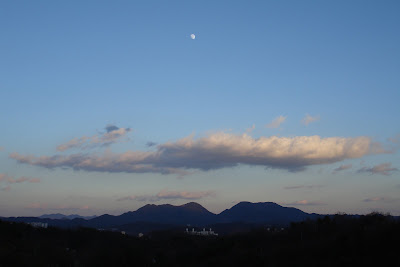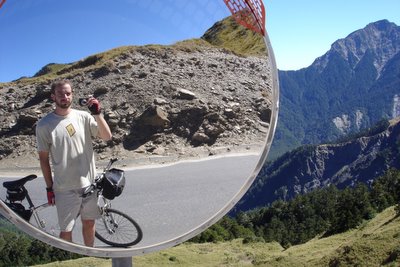 This is the English Only Zone, also know as the EZ zone (though clearly redundant). We teach in the building on the left, and we all live in the dormitories on the right. One building for the girls, and one for the boys. I've probably mentioned before that I live in the girls dormitory. As you might imagine, this is some sort of dream come true. You can also see our cafeteria in the foreground. I live, eat, and work in this small area. There is no real reason to leave.
This is the English Only Zone, also know as the EZ zone (though clearly redundant). We teach in the building on the left, and we all live in the dormitories on the right. One building for the girls, and one for the boys. I've probably mentioned before that I live in the girls dormitory. As you might imagine, this is some sort of dream come true. You can also see our cafeteria in the foreground. I live, eat, and work in this small area. There is no real reason to leave. Sometimes I do leave for a bike ride though, as I did on Sunday. This is an old section of residential Jinju that is packed into a valley away from the river.
Sometimes I do leave for a bike ride though, as I did on Sunday. This is an old section of residential Jinju that is packed into a valley away from the river. The power distribution in that area seems to have been inspired by some of the Indian cities I've visited.
The power distribution in that area seems to have been inspired by some of the Indian cities I've visited. This is obviously a bad picture, but I took it to illustrate an interesting phenomenon that might be unique to Korea. This appears to be a village. There are no other buildings withing five kilometers. Is that where the farmers that tend to those green houses live?
This is obviously a bad picture, but I took it to illustrate an interesting phenomenon that might be unique to Korea. This appears to be a village. There are no other buildings withing five kilometers. Is that where the farmers that tend to those green houses live?There seems to be a system in Korea whereby the government plans and contracts the construction of every apartment building to Hyundai, Samsung, and the other conglomerates. Individual apartments are then sold off by the government. Contrast this with our system, in which a developer proposes a building, sells the units at a price set for profit, and begins construction.
Korea's system allows for a housing allocation system, which was recently adjusted to benefit families with three or more children. This is part of the governments campaign to bring up the birthrate. If you didn't know, Korea is a country full of dinks - that is "dual income, no kids".
I'm serious, it's part of the Korean vernacular.
 Anyway, you really have to see these blocks of apartment complexes to believe it. In bigger cities there are countless areas that contain thirty or forty absolutely identical highrise apartments. These buildings are all cookie cutter copies of each other, and they are built simultaneously! The only difference between them are the giant numbers that are painted on each one to help you distinguish between them. 101, 102, 103... I imagine that Hyundai and Samsung have apartment catalogues containing five or six apartment models for local governments to choose from. Imagine how cheap they are to build compared to an independently designed and contracted apartment building. If I were so bold to pull a number out of the air, I would say that they can build them for half the cost. No need to pay for independent architectural and engineering work on every building - and I guarantee you that the boys building the apartments above have built 50 others just like them. They probably come with a manual. Step 1....
Anyway, you really have to see these blocks of apartment complexes to believe it. In bigger cities there are countless areas that contain thirty or forty absolutely identical highrise apartments. These buildings are all cookie cutter copies of each other, and they are built simultaneously! The only difference between them are the giant numbers that are painted on each one to help you distinguish between them. 101, 102, 103... I imagine that Hyundai and Samsung have apartment catalogues containing five or six apartment models for local governments to choose from. Imagine how cheap they are to build compared to an independently designed and contracted apartment building. If I were so bold to pull a number out of the air, I would say that they can build them for half the cost. No need to pay for independent architectural and engineering work on every building - and I guarantee you that the boys building the apartments above have built 50 others just like them. They probably come with a manual. Step 1.... This picture also captures something interesting about Korea. This is a section of the world map that is displayed in front of the EZ building. You will notice that an area of the map above was cut out and replaced. The name "Sea of Japan" was removed and replaced with "East Sea". This is related to sentiments over Japan's former occupation/colonization. Many people feel that the body of water separating the Corean Penninsula and Japan should have a neutral name... though there are also quite a few Coreans who think that it should just be called "Sea of Corea".
This picture also captures something interesting about Korea. This is a section of the world map that is displayed in front of the EZ building. You will notice that an area of the map above was cut out and replaced. The name "Sea of Japan" was removed and replaced with "East Sea". This is related to sentiments over Japan's former occupation/colonization. Many people feel that the body of water separating the Corean Penninsula and Japan should have a neutral name... though there are also quite a few Coreans who think that it should just be called "Sea of Corea".What's that you say? Corea? Interesting that you should ask about that.
Many Koreans actually write the word "Corea" in reference to their country. This is also related to the Japanese occupation. The argument goes that the Japanese began to romanize the name using a K, while previously a C was used. Something about making sure that Corea did not precede Japan at any international meetings (it's alphabetical see?). This has become a national issue, and strong rallying call of many a Corean nationalist.
I should note that my use of the word "Korea" is in no way an endorsement of Japanese colonial ideas or actions. In fact, I don't think that anyone's usage of the term is - apart from the Koreans who have made it an issue. That's just my value judgement though.
Those interested in the history of the Korea/Corea distinction might read about it in this interesting article, which includes historical evidence (read: cool old photos) including postage stamps, passports, and stationary suggesting the dubious nature of the claim that it was the Japanese that changed the romanization. You might also read these interesting articles about the Sea of Japan naming dispute and a letter writing campaign that some Korean students launched to bring international attention to the claims. Turns out that National Geographic has listed "East Sea" as an alternative name as a result of their efforts.
 This is a pretty average scene from the countryside in this area. Tree covered hills and well farmed valley floors spotted with farmer's houses, green houses, and little family temples.
This is a pretty average scene from the countryside in this area. Tree covered hills and well farmed valley floors spotted with farmer's houses, green houses, and little family temples. And finally, you should all know that someday I will live in a house that looks something like this one. That or a Chinese style courtyard home.
And finally, you should all know that someday I will live in a house that looks something like this one. That or a Chinese style courtyard home.

3 comments:
That is the house I was talking about! Remember somewhere in Yunnan, we where debating the right ratio of East/West architecture of our future abodes after winning the lottery--that's the one. But, you build yours first and then sell me those plans, so I can build it cheaper, Hyundai style. Also, I'd suggest adding a fence to keep the bears off your lawn and the republicans off mine.
Hi, found your blog through our mutual friends, the greidanus' and just wanted to say thanks. Being of Korean decent, I've enjoyed your pics, veiws and updates on Korea. I'm always interested in the way visitors view the country and what they have to say about it. I was born and raised in vancouver and have only visited seoul and not much of the countryside.
There are a lot of 'old'(not to demean in any way) issues that a lot of koreans still hold onto, are very relevant and a strong influence even today (such as you put it "Corean Nationalists"). A lot of people (non-koreans) can't grasp that Koreans still hold strong feelings against Japan and Japanese people.
If you have time, I suggest you visit the DMZ-South Korean Border, I recently watched a docu on cbc's the passionate eye "North Korea's Underground" and if reminded me of my visit to the DMZ in 94 and 00, how much it's changed and not changed. You can forget the harsh conditions N.Koreans live in and the feud/hatred b/w the two countries. But once you visit the border, you realize very quickly how REAL it is.
I'm proud of my background but wish I knew more about the land, I love hearing about people's experienced. So, glad to hear that you're enjoying it there, I love and appreciate it more when I'm away.
Thanks for listening.
Post a Comment